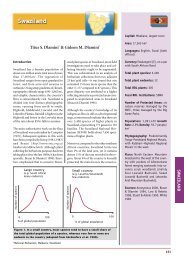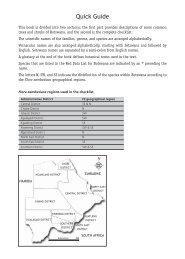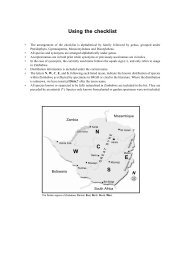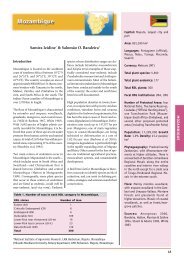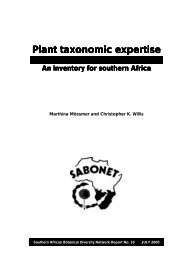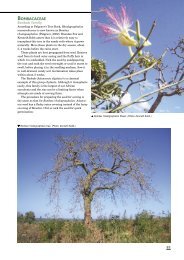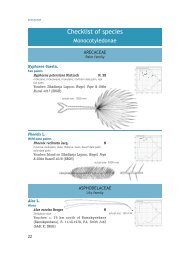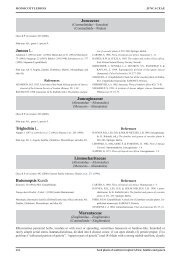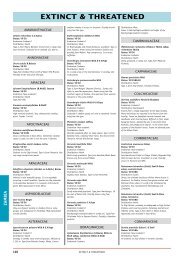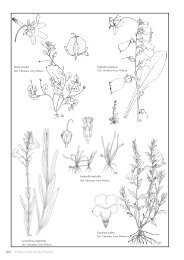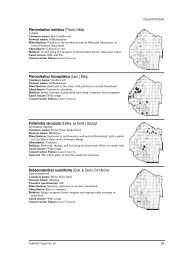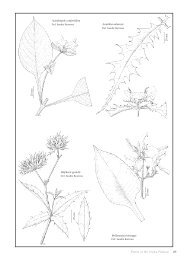141-172 - SABONET
141-172 - SABONET
141-172 - SABONET
Create successful ePaper yourself
Turn your PDF publications into a flip-book with our unique Google optimized e-Paper software.
Lesotho. Unpublished report, Department of Grassland<br />
Science, University of Natal, Pietermaritzburg. 15 pp.<br />
Noble, R.G. & Hemens, J. 1978. Inland Water Ecosystems<br />
in South Africa—A Review of Research Needs.<br />
South African National Scientific Programmes<br />
Report No. 34. 150 pp.<br />
O’Connor, T.G. & Bredenkamp, G.J. 1997. Grassland.<br />
In: Vegetation of Southern Africa, eds R.M.<br />
Cowling, D.M. Richardson & S.M. Pierce. Cambridge<br />
University Press, Cambridge, pp. 215–257.<br />
Phillips, E.P. 1917. A contribution to the flora of the<br />
Leribe Plateau and environs: with a discussion on the<br />
relationships of the floras of Basutoland, the Kalahari<br />
and the south-eastern regions. Annals of the South<br />
African Museum 16(1): 1–79.<br />
Pillans, N.S. 1934. Plants—new or noteworthy.<br />
South African Gardening & Country Life 24: 267–268.<br />
Pooley, E. 1998. A Field Guide to Wild Flowers<br />
KwaZulu-Natal and the Eastern Region. Natal Flora<br />
Publications Trust, Durban. 630 pp.<br />
Reynolds, G.W. 1934. The quest of Aloe polyphylla.<br />
The Journal of the Botanical Society of South Africa<br />
20: 11–12, plate III.<br />
Rogers, K.H. 1997. Freshwater wetlands. In: Vegetation<br />
of Southern Africa, eds R.M. Cowling, D.M.<br />
Richardson & S.M. Pierce. Cambridge University<br />
Press, Cambridge, pp. 322–347.<br />
Rowley, G.D. 1978. Rowley reporting. Aloe polyphylla<br />
is not hardy. National Cactus & Succulent Journal<br />
33(2): 42.<br />
Ruffier-Lanche, R. 1967. Aloe polyphylla from<br />
seed. National Cactus & Succulent Journal 22(1): 27.<br />
Rutherford, M.C. & Westfall, R.H. 1986. Biomes of<br />
southern Africa—an objective categorization. Memoirs<br />
of the Botanical Survey of South Africa No. 54. 98 pp.<br />
Schmitz, M. 1980. Wild Flowers of Lesotho. ESSA<br />
Educational Supplies SAPPL, Roma, Lesotho. 256 pp.<br />
Schmitz, M.O. 1984. An illustrated key for the identification<br />
of the grasses of Lesotho. National University<br />
of Lesotho, Roma. 123 pp.<br />
Schmitz-Ruch, M.O. 1973. Flowering plants of<br />
Lesotho: Grasses. Mazenod Institute, Lesotho. 123 pp.<br />
Schmitz-Ruch, M.O. 1984. Flora and vegetation. In:<br />
Lesotho: Environment and Management, ed. G.<br />
Schmitz. National University of Lesotho, Roma,<br />
pp. 31–44.<br />
Schumann, D. & Kirsten, G. (in collaboration with<br />
E.G.H. Oliver). 1992. Ericas of South Africa.<br />
Fernwood Press, Vlaeberg. 272 pp.<br />
Schwabe, C.A. 1990. A preliminary ecological evaluation<br />
of the wetlands in Sehlabathebe National Park,<br />
Lesotho. Unpublished report submitted to Natal Parks<br />
Board, Pietermaritzburg. 18 pp.<br />
Schwabe, C.A. 1995. Alpine mires of the eastern<br />
highlands of Lesotho. In: Wetlands of South Africa,<br />
<strong>SABONET</strong> News Vol. 4 No. 2 August 1999<br />
ed. G.I. Cowan. Department of Environmental Affairs<br />
and Tourism, Pretoria. pp. 33–40.<br />
Skelton, P.H. 1987. South African Red Data Book—<br />
Fishes. South African National Scientific Programmes<br />
Report No. 137. 199 pp.<br />
Smith, G.F. & Willis, C.K. (Eds) 1997. Index<br />
herbariorum: southern African supplement. Southern<br />
African Botanical Diversity Network Report No. 2:<br />
1–55. <strong>SABONET</strong>, Pretoria.<br />
Smith, G.F. & Willis, C.K. 1999a. Herbaria are<br />
forever: notes on the Sehlabathebe National Park<br />
Herbarium. Aloe: in press.<br />
Smith, G. & Willis, C. 1999b. Survival of the fittest<br />
herbarium (or surviving with a little help from the<br />
elements)—Sehlabathebe in Lesotho. Plant Talk: in<br />
press.<br />
Stuart, S.N. & Adams, R.J. 1990. Biodiversity in Sub-<br />
Saharan Africa and its Islands. Occasional Papers of<br />
the IUCN Species Survival Commission No. 6: 1–242.<br />
Talukdar, S. 1983. The conservation of Aloe<br />
polyphylla endemic to Lesotho. Bothalia 14(3&4):<br />
985–989.<br />
Talukdar, S. 1994. Botanical diversity and its conservation<br />
in Lesotho. In: Botanical Diversity in southern<br />
Africa, ed. B.J. Huntley. Strelitzia 1, National Botanical<br />
Institute, Pretoria, pp. 75–92.<br />
Van der Schijff, M. 1992. Los dié skaars aalwyn waar<br />
hy natuurlik groei! Beeld Friday 10 January 1992: 6.<br />
Van Oudtshoorn, F. 1992. Guide to grasses of South<br />
Africa. Briza Publications, Pretoria. 301 pp.<br />
Van Oudtshoorn, F. 1999. Guide to grasses of<br />
southern Africa. Briza Publications, Pretoria. 288 pp.<br />
Van Zinderen-Bakker, E.M. 1955. A preliminary<br />
survey of the peat bogs of the alpine belt of northern<br />
Basutoland. Acta Geographica 14: 413–422.<br />
Van Zinderen-Bakker, E.M. (Snr). 1981. The high<br />
mountains of Lesotho—a botanical paradise. Veld &<br />
Flora 67(4): 106–08.<br />
Van Zinderen-Bakker, E.M. (Snr) & Werger, M.J.A.<br />
1974. Environment, vegetation and phytogeography<br />
of the high altitude bogs of Lesotho. Vegetatio 29: 37–49.<br />
Wells, M.J. & Brink, E. 1992. Obituaries: Amy<br />
Francis May Gordon Jacot Guillarmod, née Hean<br />
(1911–1992). Bothalia 22(2): 295–300.<br />
White, F. 1978. The Afro-montane region. In: Werger,<br />
M.J.A. (ed.). Biogeography and Ecology of southern<br />
Africa. Volume 1. Dr W. Junk bv Publishers, The<br />
Hague, pp. 463–513.<br />
White, F. 1983. The Vegetation of Africa. UNESCO,<br />
Paris. 356 pp.<br />
Witzsch, G. 1992. Lesotho Environment and Environmental<br />
Law. National University of Lesotho, Roma. 280 pp.<br />
Zacharias, P.J.K. 1990. Acocks’ notes: key grasses of<br />
South Africa. Grassland Society of southern Africa,<br />
Howick. 77 pp.<br />
155



